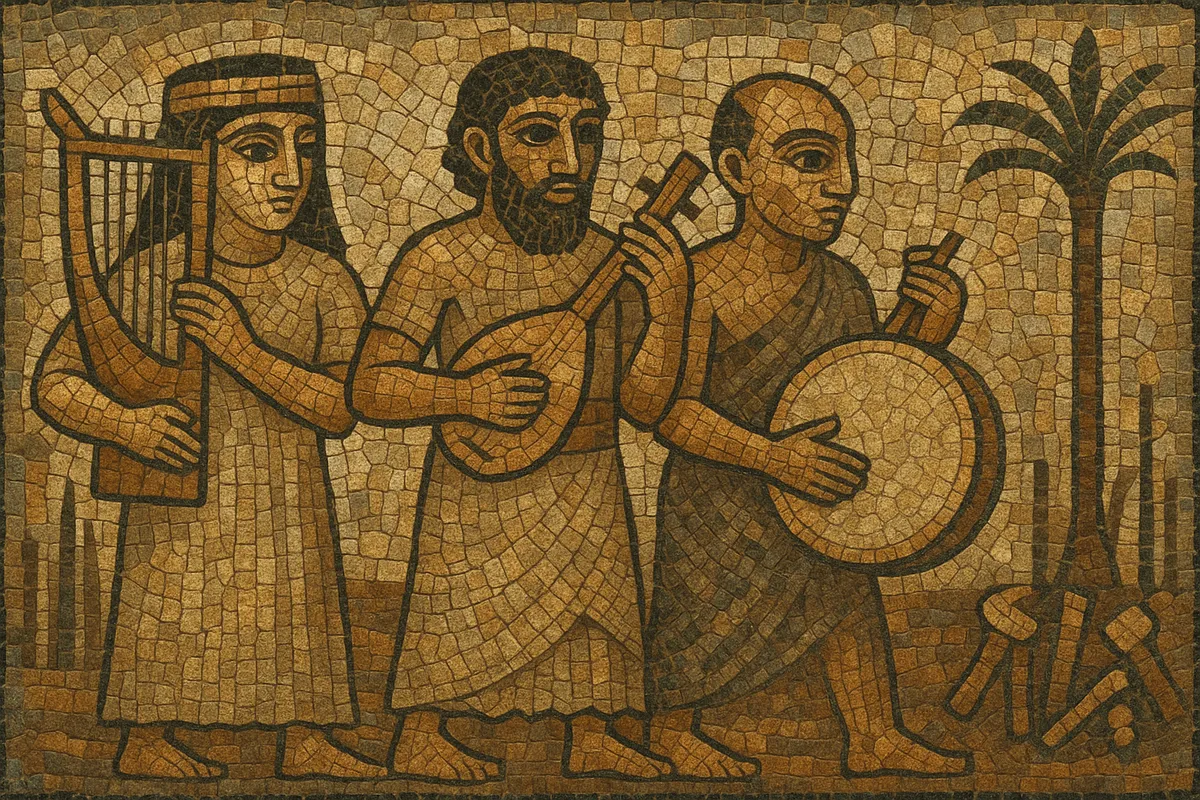Mesopotamian music refers to the ritual, court, and popular musical practices of Sumer, Akkad, Babylonia, and Assyria in ancient Mesopotamia.
Known through archaeological finds (such as the Royal Tombs of Ur), iconography, literary texts, and cuneiform music-theory tablets, it features lyres and harps as core instruments, supported by drums, clappers, and later lutes. Surviving theory describes named heptatonic tunings and intervallic frameworks, suggesting a diatonic pitch system and formulaic melodic practice. Performance contexts ranged from temple hymns and laments to royal celebrations and processions, often delivered by trained priest-musicians and court ensembles.
Archaeological discoveries from the Royal Tombs of Ur reveal richly decorated lyres and harps, indicating an already sophisticated musical culture servicing temples and courts. Sumerian texts attest to professional singer-priests, lamentation specialists, and ritual ensembles supporting civic-religious life.
Cuneiform tablets from Mesopotamia record one of the world’s earliest music-theory traditions. They list named tunings (e.g., išartum, nīd qabli, kitmūrum, qablitum), describe intervallic relationships, and reference string orders for lyres/harps. These materials imply heptatonic diatonic systems, formula-based composition, and pedagogies transmitted among scribal-musician elites.
Iconography from Assyrian palaces shows larger, more formalized ensembles (lyres, angular harps, percussion, possibly double-pipes), used in royal ceremonies, warfare processions, and state rituals. Temple laments, hymns, and praise songs remained central, aligning musical structure with poetic meter and ritual function.
After Mesopotamia’s incorporation into larger empires, musical practice persisted but hybridized with regional traditions. The theoretical heritage and performance models of Mesopotamia informed the broader Near Eastern sound world, shaping the foundations that later affected Greek, Persian, Syriac, and early liturgical repertoires.
From the 20th century onward, Assyriologists and archaeomusicologists interpreted theory tablets and instruments, while modern ensembles and instrument makers reconstructed lyres/harps (e.g., Ur lyre replicas) and created historically informed performances from Sumerian and Akkadian texts.
Use a lyre or angular harp as the lead instrument; add frame drums, small kettledrums, clappers, and rattles for processional or ritual energy. Where appropriate for later periods, experiment with early long‑necked lutes and double-pipes.
Adopt one of the attested heptatonic tunings (e.g., išartum, nīd qabli, kitmūrum, qablitum) and treat it as a diatonic framework. Emphasize stepwise motion, recurring cadential tones, and formulaic motifs rather than functional harmony. Maintain a primarily monophonic or heterophonic texture.
Align rhythmic phrasing to poetic meter (hymn or lament strophes). Use ostinati on drums and repeated melodic formulas on lyre/harp. Favor responsorial textures (soloist and small chorus) and antiphony (priests vs. chorus) to reflect temple practice.
Set Sumerian or Akkadian texts (hymns, laments, praise songs). If ancient languages are unavailable, emulate their structure with concise, invocatory lines, epithets of deities, and repetitive refrains. Vocal delivery should be declamatory, ornamented sparingly, with clear textual projection.


